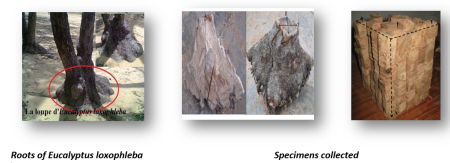
Objective:
In Tunisia, handicrafts based on local wood are mostly from olive wood. Due to its physical, mechanical and aesthetic qualities, olive wood is highly sought and appreciated by artisans and buyers. In front of the growing demand for this wood, local people do not hesitate to resort to illicit cuts to satisfy the needs of the market. The objective of this study is to search for forest species offering wood qualities that rival those of olive wood and that can be valorized for artisanal use.
Context:
The measurements of the physico-mechanical properties of wood samples from stem and roots (lignotuber) of E. loxophleba are carried out according to Tunisian standards:
- The measured physical properties: Moisture content, density, and shrinkage.
- The determined mechanical properties: static bending, axial compression, and Brinell hardness.
- In order to evaluate the craft behavior, the roots were sculpted by a professional craftsman.
Wood samples were taken from 3 representative trees from the El Hanya arboretum (Sousse) d’El Hanya (Sousse).
Contacts:
ibtissem taghouti
ibtissem.taghouti@gmail.com
Authors : ELAIEB Mohamed Tahar, Sarra Ben Rhouma, Mohamed Larbi KHOUJA
E-mail : medtahar.elaieb@iresa.agrinet.tn
Further information:
Ben Rhouma S., 2015. Étude de la biomasse forestière, du comportement physico-mécanique et du collapse du bois de quelques espèces d’Eucalyptus introduites en Tunisie: Cas d’Eucalyptus loxophleba et d’Eucalyptus salmonophloia. Projet de fin d’études du cycle ingénieur.Institut National Agronomique de Tunisie, 144 p.
CIRAD., 1998. Synthèse sur les caractéristiques technologiques de référence des principaux bois commerciaux africains. Série FORAFRI, document 11, France, 185 p.
El Mouridi M, Laurent T,Famiri A, Kabouchi B, Alméras T, Calchéra C, El Abid A, Ziani M, Gril J, Hakam A., 2011. Caractérisation physique du bois de la loupe de thuya (TetraclinisArticulata (Vahl). Phys. Chem. News, V(59), 57-64.